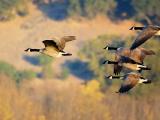Jul 13, 2004 (CIDRAP News) – H5N1 avian influenza viruses circulating in ducks in China gradually increased their ability to infect mammals between 1999 and 2002, but just how that happened remains unclear, according to a recent study by Chinese researchers.
The scientists isolated H5N1 viruses from apparently healthy ducks in southern China between 1999 and 2002 and then injected them into chickens and mice, according to the report in the Proceedings of the National Academy of Sciences. Over the 4 years, the viruses somehow became increasingly able to sicken and kill the mice.
"Our results demonstrate that while circulating in domestic ducks, H5N1 viruses gradually acquired the characteristics that make them lethal in mice," says the report by Hualan Chen and colleagues at the Harbin Veterinary Research Institute in Harbin, China. R. G. Webster of St. Jude's Children's Research Hospital in Memphis also worked on the research.
While causing widespread devastation in Asian poultry flocks last winter and spring, H5N1 viruses caused at least 34 human illness cases, 23 of them fatal. New outbreaks in poultry have been reported recently in Thailand, Vietnam, and China, though without any human cases so far.
The report says there was "no convincing evidence of repeated transmission of avian viruses to humans" until 1997, when H5N1 virus jumped from birds to humans in Hong Kong and killed 6 of 18 people infected. Following that outbreak, disease experts began routine surveillance of influenza viruses in apparently healthy ducks in southern China.
As part of that surveillance, the authors isolated 21 varieties of H5N1 viruses from ducks between 1999 and 2002. The viruses were cloned and then inoculated intravenously or intranasally into groups of chickens and mice.
The viruses proved to be quickly lethal to nearly all of the chickens. In the mice, the viruses grew increasingly pathogenic with time. With very few exceptions, viruses isolated in 1999 and 2000 were less pathogenic than those isolated in 2001 and 2002, the report says. All the isolates classified as highly pathogenic dated from 2001 and 2002.
In a search for the molecular basis of the differences in pathogenicity, the investigators sequenced the entire genome of all 21 viruses. They determined that the viruses formed nine genotypes, but they found "no strong links" between the genotypes and pathogenicity. But within the genotypes, there was "a clear temporal pattern" of increasing pathogenicity.
"The molecular basis of the transmissibility of avian influenza viruses to mammals is not resolved," the article states. But the authors speculate that the mechanism has to do with possible traffic in viruses between ducks and pigs living close together on small farms.
"Our working hypothesis is that H5N1 viruses have gradually acquired the ability to replicate in mammals by means of selection pressure created by possible transmission between pigs and ducks," the report says. H5N1 viruses have not yet been found in pigs, but the authors say they have "preliminary virological and serological evidence of H5N1 virus infection in pigs in Fujian province."
The report concludes, "Clearly, H5N1 influenza viruses are continuing to evolve in Asia. Continued surveillance is needed, as is detailed characterization of the gene constellations and specific residues required for transmission to mammals."
Chen H, Deng G, Li Z, et al. The evaluation of H5N1 influenza viruses in ducks in southern China. Proc Nat Acad Sci 2004 Jul 13;101(28):10452-7 [Full text]





















